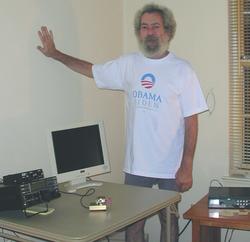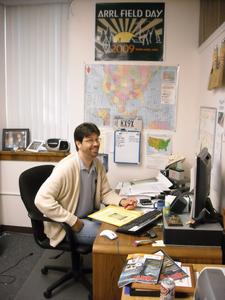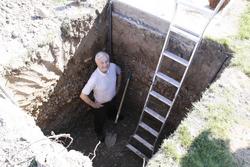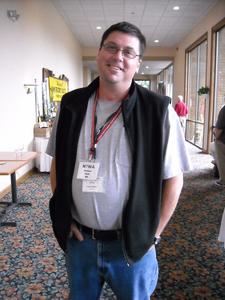 September 2, 2009 Editor: Ward Silver, NØAX | ||||||
IN THIS ISSUE
NEW HF OPERATORS - THINGS TO DO For chasing DXCC and regional DX awards, the opportunities provided by a continental or country-specific DX contest are boundless. Try the phone weekend of the All Asia contest this coming weekend. The contest often brings out special event stations and makes it a little easier to work some of those missing counters than during the big contests coming up later this season! BULLETINS A small sunspot group from Cycle 24 has emerged and is making its way across the solar disc! BUSTED QSOS The server for the Russian IARU maps mentioned in the last issue quickly exceeded its allotted download limits and made itself unavailable. There is no way to know what the limits are in advance, unfortunately. If another source of these maps appears, it will be reprinted. Last issue's link to the CQ WPX survey may not have worked for everyone. The survey is now open to all and will remain so until September 10th. (Thanks, CQ WPX Director, Randy K5ZD) CONTEST SUMMARY Complete information for all contests follows the Conversation section Sep 5-6
Sep 12-13
NEWS, PRESS RELEASES, AND GENERAL INTEREST The Pacific Northwest VHF Society is sponsoring the 16th annual Pacific NW VHF Conference at the Oceanfront Resort in Seaside, Oregon over the weekend of 9 - 11 October. This is always an enjoyable event and Seaside has lots to do for other family members. The conference will be attended this year by QST's "World Above 50 MHz" editor W3ZZ, as well. The ARRL School Club Roundup is coming up in October - maybe you know a school club that could use some encouragement and guidance? If your school doesn't have a ham radio club, this would be a great opportunity to demonstrate ham radio. Now is the time to approach a teacher or administrator about it! If you do find a friendly ear, there's no need to put up a huge station - a 20-meter or 40-meter dipole in the clear will probably generate plenty of QSOs with a 100-watt radio. Limit the number of kids to a manageable group at any particular time so they all get a chance for some hands-on time - take sign-ups for specific afternoons or time periods? (The contest runs on weekdays from Oct 19-23.) Enlisting the help of a young contester to serve as instructor and coach would help. You could even see which afternoon's teams do the best and have a post-contest pizza party and woofing match! Make sure your score is posted to 3830 right away and other scores shared with the operators - timely feedback is very important. The rest of us can put the SCR on our to-do list for that week and spend some time making QSOs with the clubs.
More on encouraging entry-level interest in ham radio - Ken KE3X suggests calling the local Scoutmaster and volunteering to be a Radio merit badge counselor. (This is the Boy Scouts of America program - there may be something similar for other youth groups.) Any adult over the age of 18 can be a Merit Badge Counselor - it's very straightforward. Running a Radio Merit Badge class takes just a few hours in a single afternoon and it can be combined with a local hamfest for even more ham radio and electronics fun for the kids. While you're at it, don't forget to get the parents and scoutmasters interested, too! IEEE members can follow up with the article "Publicizing the "Cool" Factor in Engineering and Technology". Explaining how new technologies are being applied to "cool" applications is one of the tasks of the IEEE Public Visibility Initiative, a communications program seeking to raise IEEE's global visibility and increase public understanding of how engineering, computing, and technology benefit humanity. All hams can relate to the August 23rd story in the New York Times, "Hello, Oven? It's Phone. Now Let's Get Cooking!" I think this fellow needs an amplifier, don't you? The Daily DX relays news that St Maarten (PJ7) and Curacao (PJ2) will become countries within the Dutch Kingdom (similar to the British Commonwealth) by October 2010, just in time for CQ WW SSB. Consequently, the status of Bonaire (PJ4), St Eustatius (PJ5), and Saba (PJ6) could also evolve. Should a change in status occur, there will no doubt be a change in the DXCC and CQ DX status, as well. Watch for news on the subject and be prepared for an update in the CTY files your logging software uses, too. Version 2.0 of GJTRACKER by Lance W7GJ is now available, including a fairly detailed world Field Locator map to show what parts of the world can see the moon (or any other celestial object). The help file has been updated to reflect this new addition to the Real Time window.
Pssst - you're one of more than two thousand dozen subscribers. We passed 24,000 in the last issue - tell your friends and get them to sign up, too! Web Site of the Week - Oh, here's a fun Web toy - it's an antenna tuner simulator by W9CF, another in his line of useful and interesting Java applets. Set up the load impedance and spin the dials to practice using the tuner. See if you can tune for a match with better efficiency than the Autotune function! (Thanks, Carl WA1ZCQ) WORD TO THE WISE Equinox - Whether vernal (spring) or autumnal, HF conditions change rapidly around these dates because these are the times at which the daily ration of sunlight is changing the most rapidly. (Think of a sine wave around its zero-crossing.) The terminator between day and night also passes directly over both poles at the equinox, leading to some interesting opportunities for rare multipliers and contacts with locations more difficult at other times of the year. SIGHTS AND SOUNDS Thor TF4M is building a very large 160 meter transmit antenna and once it is ready he says, "You will hear my signals although the US does not have an open salt water path." No doubt about it, TF should be a lot easier to work this year due to his efforts. This is part news, part technical, and 100 percent sights and sounds - Eric K1TTV recommends the entertaining and informative Electronic Engineering Video Blog. (vlog?) Hosted by Sydney, Australia resident David Jones, each topic is covered in a 10-minute video. Current topics include "The Unusual Oscilloscope Phenomenon", "The Infinite Resistor Puzzle", and more. Is this guy a ham? You bet! Bob N6TV reports that he would have been more impressed had the inventors programmed this robotic hand to send CW with paddles at 60 WPM. It's pretty amazing anyway. Bob muses, "Maybe someday we'll all have a robot hand that can climb up a tower and out onto the boom for us (think "Thing" from The Addams Family)." Thank you, Thing! Bruce W9FZ/R has put together some impressive graphics of his activity in the recent ARRL UHF contest. Now that's quite a machine! Here's a Quicktime video about how they do Field Day in Utah by Chris KF7P. The page has lots of other topics on it, too! RESULTS AND RECORDS Certificates and plaques for the 2008 ARRL November Sweepstakes, (Phone and CW) - the 75th running of this venerable event - went out the door recently and are reported to be walking into shack doors across the land. Get ready for this year's Sweepstakes, only two months away! (Thanks, ARRL Contest Branch Manager, Sean KX9X)
Claimed Scores of the WAE DX Contest CW 2009 have been published online. They are located in the Results 2009 pages. If you submitted a log, check these listings to be sure your log was received OK. (Thanks, Joerg, DL8WPX) OPERATING TIP Has your tongue turned to tar by Sunday afternoon of a phone contest? It may be your phonetic's fault! Remembering using the tongue-tangler "Spain Germany Japan" in a long-ago Sweepstakes, I suggest practicing with several variations or substitutes. Pick the set that gives the most natural speaking "feel" so that your call sign is easy to say and to understand. For example, "Able X-ray" is a lot easier to say over and over than "Alpha X-ray" or "America X-ray". To test your phonetics, say them tentimesreallyfast and if they don't run together, you may have a winner. Over the air tests also help. You wouldn't tolerate sloppy Morse - why not clean up your voice ID, too? TECHNICAL TOPICS AND INFORMATION Here's a product designed to un-do all that hard work you put in on waterproofing your connectors. Made by 3M, it's called "caulk remover" and it's designed to soften up even silicone sealants so they can be removed. It's available from home improvement stores and on-line. (Thanks, Bob N6TV) Ed K1EP has improved the K1DG boom mike modification for Bose noise-canceling headphones. The new procedure uses a mini-gooseneck Heil Pro-Set mike boom, making the assembly much more robust. (Thanks, Doug K1DG) Dino KX6D relayed some good information on anchor bolts and the applicable standards. "The ASTM F1554 specification was introduced in 1994 and covers anchor bolts designed to anchor structural supports to concrete foundations. F1554 anchor bolts can take the form of either headed bolts, straight rods, or bent anchor bolts. The three grades 36, 55, and 105 designate the minimum yield strength (ksi) of the anchor bolt. The bolts can be either cut or roll threaded and a weldable grade 55 can be substituted for grade 36 at the supplier's option. Color coding on the end - 36 blue, 55 yellow, and 105 red -- helps facilitate easy identification in the field. Permanent manufacturer and grade marking is allowed under the S2 supplementary requirements." Portland Bolt's Web site provides full information on the specification.
Trying to get rid of a concrete base, instead? Kevin Normoyle contributed links to the following products; Betonamit, Dexpan, and Sylentmite. These are poured into holes or cracks and break the concrete apart by expanding as they set or cure. Similar products are Crack Dexpan, Crack Ag, Crackamite, Split Ag, Bristar, Bustar by Cras, Da-Mite, Nonex, S-mite, Fract Ag, and Rockfrac. I guess this is a common problem! Here are all the references to formulas for inductance you could ever want! And here's an article about the self-resonance of inductors. As the author points out "Of the three basic passive components -- resistors, capacitors, and inductors - inductors are the least ideal and, therefore, the most difficult to model." (Thanks, Jim W6RMK and Bill W6WRT) Pete N4ZR relays a link to "three very-detailed technical articles by Dallas Lankford dealing with SDRs, particularly the SDR-IQ and Perseus. He presents some modifications for the SDR-IQ to improve strong-signal performance, and offers a detailed technical appraisal of the strong-signal performance of the Perseus receiver." Operating onboard a vessel of some sort poses interesting grounding challenges. Bob N6TV found this Web page on RF grounding in such cases on the SailMail Web site. Or you can log on to the home page and scroll down to "RF Ground". If you are experiencing QRM from leaking cable TV systems, watch out for folks that have an antenna connected to the cable system with a T-connector and not a switch. That connection re-radiates the cable system signals over the air. Adding the switch reduces leakage considerably. (Thanks, Roger K8RI) Technical Web Site of the Week - As you get busy completing that new low-band vertical, this classic National Contest Journal article by K3LC will help you figure out how to get the most signal bang for your radial buck. (Thanks, Ed N5DG) CONVERSATION Getting Better All the Time We all plan on "doing better this year" as the classic QST covers of Field Day, Sweepstakes, and ARRL DX "before-and-after" cartoons so memorably capture. Why not learn from the masters? Nat WZ3AR posted a list of his favorite operating improvement articles from CQ-Contest, all available from the CQ-Contest archives. I try to offer up a bon mot from time to time, but these authors are REALLY good (and occasionally FUNNY): Beware the DVP! (N6TR) Don't Try This At Home (N6AA) Shhhh...it's a Secret (K1AR) What REALLY makes you good? (N5KO) Improving Concentration (K5TR) How do you get better? (K5ZD) How do you get better? A few more ideas (KQ2M)
The amount of walnut and parchment hanging on the walls of these authors is enough to build and wallpaper a complete new shack! Many of the ideas in these articles can be directly applied to just about any area of ham radio and, read broadly, life in general. One such idea not expressed directly, but exhibited in bucket loads, is that of generosity with your time and ideas. Ours is a hobby of communication in which the very essence is built on two-way cooperation with another ham. It doesn't do us much good to build a big station if we don't share it with others! Combining generosity with a mantra of continuous training and improvement makes us all better, step by step. Why not start this season? What did you learn from the weekend's competition? We all learn something (even if we didn't want to) and there are others in our club, contest or not, that would benefit from hearing your story, no matter how simple the lesson. Ham radio is a vast collection of ladders we all climb one rung at a time. There's always somebody a few rungs higher and lower on some ladder. Help those lower reach for the next one, just as you reach up for help on your own journey. That way we're all getting better all the time! CONTESTS 2 September to 15 September An expanded, downloadable version of QST's Contest Corral in PDF format is available. Check the sponsor's Web site for information on operating time restrictions and other instructions. HF CONTESTS All Asia Contest--Phone, from Sep 5, 0000Z to Sep 6, 2400Z. Bands (MHz): 3.5-28. Exchange: RS and age ("00" for YL). Logs due: Sep 29. Rules Russian Radio RTTY WW--Digital, from Sep 5, 0000Z to Sep 5, 2400Z. Bands (MHz): 3.5-28. Exchange: RST and oblast or WAZ zone. Logs due: Oct 14. Rules DARC 10-Meter Digital "Corona"--Digital, from Sep 5, 1100Z to Sep 5, 1700Z. Bands (MHz): 28. Exchange: RST and serial. Rules Colorado QSO Party--Phone,CW,Digital, from Sep 5, 1200Z to Sep 6, 0400Z. Bands (MHz): 1.8-28, 50+, Frequencies: CW--1.850, 3.550, 7.050, 14.050, 21.050, 28.050; Phone--1.870, 3.850, 7.250, 14.250, 21.350, 28.450. Exchange: Call sign, name, and county or S/P/C. Logs due: Oct 6. Rules IARU Region I Field Day--Phone, from Sep 5, 1300Z to Sep 6, 1300Z. Bands (MHz): 1.8-28. Exchange: RS and serial. Logs due: 16 days. See IARU Society Web pages for details. Tennessee QSO Party--Phone,CW,Digital, from Sep 6, 1800Z to Sep 7, 0300Z. Bands (MHz): 1.8-28, 50+. Exchange: RS(T) and county or S/P/C. Logs due: Oct 8. Rules Labor Day Sprint--CW, from Sep 7, 2300Z to Sep 8, 0300Z. Bands (MHz): 1.8-28, 50. Exchange: RST, S/P/C, MI QRP nr or power. Logs due: Oct 8. Rules 070 Club KA3X Memorial Sprint--Digital, from Sep 11, 8 PM to Sep 12, 2 AM. Bands (MHz): 3.5. Exchange: RST and S/P/C. Logs due: Oct 11. Rules WAE DX Contest--Phone, from Sep 12, 0000Z to Sep 13, 2400Z. Bands (MHz): 3.5-28. Exchange: RS and serial. Logs due: Sep 28. Rules Arkansas QSO Party--Phone,CW,Digital, from Sep 12, 1400Z to Sep 13, 0600Z and Sep 13, 1500Z to Sep 13, 2400Z. Bands (MHz): 3.5-28, 144, Frequencies: CW--3.550, 7.050, 14.050, 21.050, 28.050; Phone--3.980, 7.260, 14.260, 21.360, 28.360, 145-147. Exchange: RS(T), county or S/P or "DX". Logs due: Nov 15. Rules Ohio State Parks On the Air--Phone,CW,Digital, from Sep 12, 1600Z to Sep 12, 2400Z. Bands (MHz): 3.5-28, 50,144. Exchange: "Ohio" or S/P/DX and Park ID. Logs due: 30 days. Rules Second-Class Operators Sprint--CW, from Sep 12, 1800Z to Sep 12, 2400Z. Bands (MHz): 1.8-28. Exchange: RST, S/P/C, SOC nr or power. Logs due: 30 days. Rules North American Sprint--CW, from Sep 13, 0000Z to Sep 13, 0400Z. Bands (MHz): 3.5-14. Exchange: Call signs, serial, name, and state. Logs due: 7 days. Rules VHF+ CONTESTS ARRL September VHF QSO Party--Phone,CW,Digital, from Sep 12, 1800Z to Sep 14, 0300Z. Bands (MHz): 50+. Exchange: Grid square. Logs due: Oct 8. Rules Colorado QSO Party--Phone,CW,Digital, from Sep 5, 1200Z to Sep 6, 0400Z. Bands (MHz): 1.8-28, 50+, Frequencies: CW--1.850, 3.550, 7.050, 14.050, 21.050, 28.050; Phone--1.870, 3.850, 7.250, 14.250, 21.350, 28.450. Exchange: Call sign, name, and county or S/P/C. Logs due: Oct 6. Rules Tennessee QSO Party--Phone,CW,Digital, from Sep 6, 1800Z to Sep 7, 0300Z. Bands (MHz): 1.8-28, 50+. Exchange: RS(T) and county or S/P/C. Logs due: Oct 8. Rules Labor Day Sprint--CW, from Sep 7, 2300Z to Sep 8, 0300Z. Bands (MHz): 1.8-28, 50. Exchange: RST, S/P/C, MI QRP nr or power. Logs due: Oct 8. Rules Arkansas QSO Party--Phone,CW,Digital, from Sep 12, 1400Z to Sep 13, 0600Z and Sep 13, 1500Z to Sep 13, 2400Z. Bands (MHz): 3.5-28, 144, Frequencies: CW--3.550, 7.050, 14.050, 21.050, 28.050; Phone--3.980, 7.260, 14.260, 21.360, 28.360, 145-147. Exchange: RS(T), county or S/P or "DX". Logs due: Nov 15. Rules QRP ARCI VHF Contest--Phone,CW,Digital, from Sep 12, 1900Z to Sep 13, 0400Z. Bands (MHz): 50+. Exchange: Grid square. Logs due: Oct 13. Rules LOG DUE DATES 2 September to 15 September September 2 - RSGB 80m Club Sprint, SSB, email logs to: cwsprint.logs@rsgbhfcc.org, upload log at: http://www.vhfcc.org/cgi-bin/hfcover.pl, paper logs and diskettes to: (none), Rules September 14 - New Jersey QSO Party, email logs to: w2rj@arrl.net, paper logs and diskettes to: Englewood ARA, P.O. Box 528, Englewood, NJ 07631-0528, USA. Rules September 14 - Maryland-DC QSO Party, email logs to: WA3EOP@arrl.net, paper logs and diskettes to: Antietam Radio Association, P.O. Box 52, Hagerstown, MD 21741-0052, USA. Rules September 14 - SARL HF CW Contest, email logs to: hfcontests@netactive.co.za, paper logs and diskettes to: Bloemfontein Radio Amateur Club, Box 12104, Brandhof, 9324, South Africa. Rules September 15 - ARCI Silent Key Memorial Sprint, email logs to: contest@qrparci.org, paper logs and diskettes to: ARCI Silent Key Memorial Sprint, c/o Jeff Hetherington, VA3JFF, 139 Elizabeth St. W., Welland, Ontario L3C 4M3, Canada. Rules September 15 - SCC RTTY Championship, email logs to: rtty@hamradio.si, paper logs and diskettes to: Slovenia Contest Club, Saveljska 50, 1113 Ljubljana, Slovenia. Rules ACKNOWLEDGEMENTS ARRL Contest Update wishes to acknowledge information from WA7BNM's Contest Calendar and SM3CER's Contest Calendar. | ||||||











